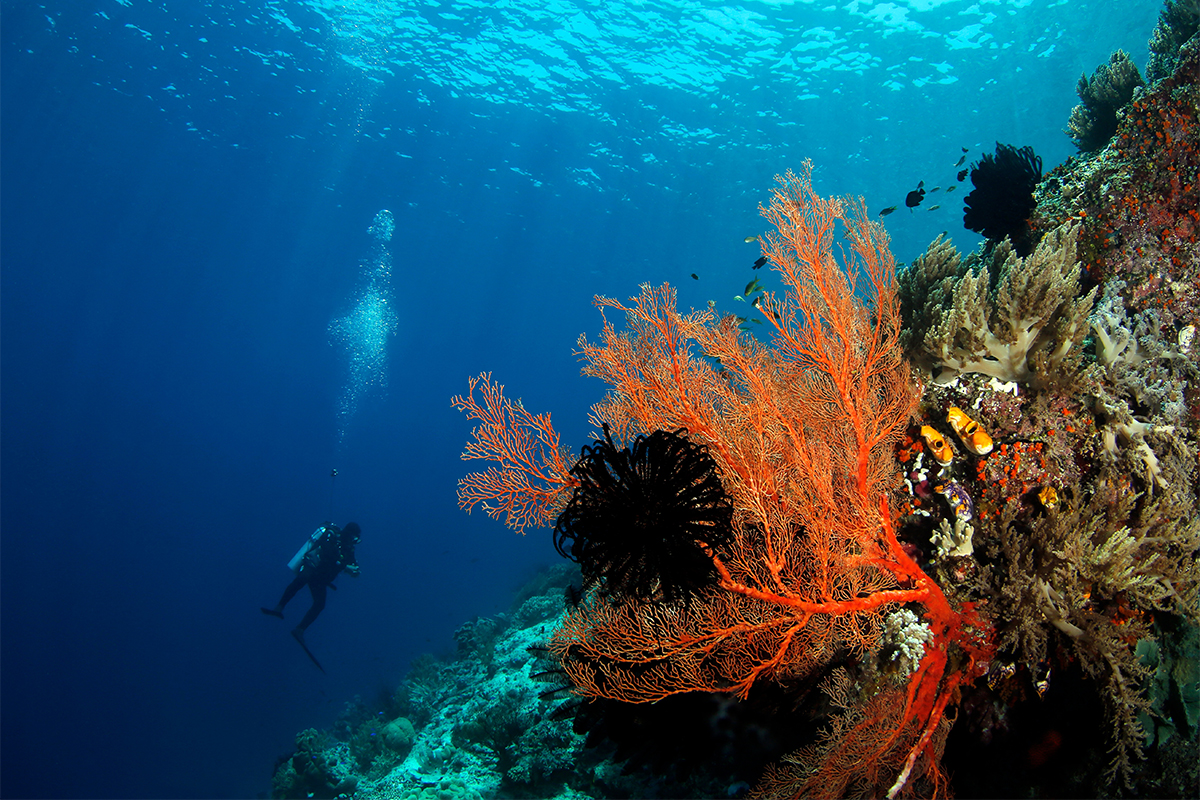- More More
- Blog
- Inspire me
- Groups
- Offers More
- Dive Courses More
- Liveaboards
More

Liveaboard Trips
On-board accommodation offering the opportunity to live right over the dive sites and to experience secluded dives...
Diving regions...
- LATEST AVAILABILITY BY REGION
- Red Sea availability
- Maldives availability
- Indonesian availability
- Socorro Mexico availability
- Galapagos availability
- ALL LIVEABOARD DIVING REGIONS
- Bahamas
- Bikini Atoll
- Caribbean
- Cocos Island
- Destinations
MoreDIVING REGIONS...
Our Top destinations....Why not try....
Halmahera - Raja Ampat
This exceptional itinerary allows you to explore the pristine beauty of the area, both above and below the water. Raja Ampat's islands are mostly uninhabited, with only the faint glow of a few night lights from small villages and fishing boats on the horizon and this lack of population pressure ensures abundant marine life and vibrant habitats. The emerging area of Halmahera, at the gateway to the Pacific, provides a truly diverse habitat and last but not least Lembeh Straits offer the best ‘macro diving’ on Earth!
The variety of marine life can be amazing, offering encounters with enormous schools of fish and regular sightings of sharks, manta rays and turtles. These are Indonesia's if not the world's finest diving destinations for anyone with a serious interest in rare and unusual marine life.


ITINERARY HIGHLIGHTS
- Explore the pristine reefs of Raja Ampat, famous for its manta ray encounters and vibrant coral gardens.
- Discover the hidden gems of Halmahera, a relatively unexplored region with exceptional diving opportunities.
- Dive the world-renowned Lembeh Strait, a muck diving paradise teeming with unique marine creatures.
- Witness schools of barracuda, triggerfish, and other pelagic species in Dampier Strait.
- Experience the stunning beauty of Misool Island, known for its soft coral reefs and diverse marine life.
Some of the dive sites you may visit on your liveaboard include:
Dampier Strait: The best known dive sites are Cape Kri, Sardine Reef, Chicken Reef, Mioskon, Blue Magic, Mikes Point, Manta Sandy, Arborek Jetty, Mangrove and Citrus Ridge. All the dive sites around the Strait are known for the huge amount of schooling fish; barracudas, bigeye trevallies, oceanic triggerfish, spadefish, surgeonfish, and snappers. Apart from schooling fish, this is an area where we get to see blacktips, whitetips, and wobbegongs sharks. Some of the best manta dives are here at Manta Sandy and Blue Magic. Manta Sandy is a sandy slope with several bommies that the mantas use as a cleaning station. Blue Magic is a small pinnacle where giant mantas congregate for cleaning. Some of the best mangrove dives are also located in the Strait, around the islands of Yanggefo and Gam. The area is also well known for the bommies found in shallow areas of the reefs. Some of these bommies are covered with beautiful soft corals and host a profusion of glassfish. Of course, we can't forget the dive sites in some of the local villages, where the pillars of the jetties are covered in soft corals and small critters.
Batanta Island: The south-west coast of Batanta is known for sheltered black sand bays and critters – a stark contrast to the vibrant and dynamic reefs Raja Ampat is generally famous for. The dive sites offer some excellent opportunities for muck diving.
Misool: The most southern island in Raja Ampat is surrounded by several hundred small islands and rocks. Some of the nicest soft coral reefs in the world are located in Misool. It's impossible to describe only several dive sites, since there are literally hundreds of them. Every year new dive sites are discovered around Misool. Many of the dive sites around Misool are just as fishy as the ones from the Dampier Strait, with same schools of barracudas, spadefish, pinjalo snappers, and zillions of fusiliers. But Misool is also a great macro place. It's known as the kingdom of the pygmy seahorses, as well as having small allied cowries in the gorgonian seafans, and nudibranches. Within each of the following areas, there are always several dive sites. Wagma, Farondi, Balbulol, Sagof, Daram, Yellit, Boo, Warakaraket, Fiabacet, Kalig, Wayilbatan, Wayil, Pele and Nampele (Blue Water Mangroves).
Pulau Pisang: These are a set of two islands and two small rocks between Misool and Halmahera. The dive sites feature sloping reefs with healthy soft coral on the deeper areas and hard coral bommies in the shallows. When the currents are strong, the sites can be very fishy with schooling bumphead parrotfish, zillions of blue triggerfish and dogtooth tunas passing by.
Halmahera: Lying at the gateway to the Pacific Ocean and between Lembeh Strait and Raja Ampat, Halmahera promises exceptional diving opportunities at the very heart of the Coral Triangle. Once at the centre of the spice trade, the lush volcanic island of Halmahera is now a quiet outpost of the Indonesian archipelago, a land that time has long since forgotten. Despite its location at the very centre of the richest and most diverse waters on Earth, the largest island in the Moluccas has remarkably escaped the attention of divers clamouring to visit Indonesia's many other diving meccas. This area is finally beginning to open up and represents a new and exciting frontier for adventurous divers. The waters around this sparsely populated island play host to pristine, untouched reefs and an astounding biodiversity. While the waters are still relatively unchartered, a survey in 2005 suggested that Halmahera is comparable only to Raja Ampat - currently considered the most diverse habitat on Earth - with at least 450 species of coral and over 800 species of fish recorded in just a few hours. The wider region, much of which is still to be explored, boasts almost 400 islands, plunging drop-offs, atolls, pinnacles and vibrant coral gardens hiding countless macro delights such as the pygmy seahorse, blue-ringed octopus and flamboyant cuttlefish. Larger visitors include turtles, schools of barracuda and batfish, eagle rays, bumphead parrotfish and graceful manta rays (Sep-Oct), and a new species of walking shark has been discovered in the region (hemiscyllium halmahera). Although the area can be dived by liveaboard throughout the year, the best months for diving are considered to be from Oct-May. The itineraries concentrate on the south-western side of Halmahera, exploring the dive sites around Bacan, Moti, Tidore and Ternate islands. Halmahera's remote location and the possibility of stronger currents mean the diving is most suitable for more experienced divers with at least 50 logged dives. It's a photographer's dream!
Pulau Tifore: A small island between Halmahera and Lembeh with a great submerged reef about ½ mile from the island. The main attraction here is definitely the barracudas – hundreds and hundreds have made this their home for years. Really amazing especially if you can get inside the swirling vortex of the barracudas.
Lembeh Strait: Some of the best muck diving in Indonesia, a black sand environment full of critters. Attracting marine experts from around the world, Lembeh Strait is home to a huge array of rare and unusual marine life, with new species often being discovered. With over 180 species of fish already listed in just one small area in the bay, this is the world’s finest diving destination for anyone with a serious interest in marine creatures and critters. There are over 50 dive sites to discover within the Strait, which are easily accessible throughout the year. Although black volcanic sand sites dominate the topography, there are patch reefs, sand and rubble sites and even a couple of wrecks, all of which are home to an incredible wealth of marine life. Conditions in the Strait are generally calm with clear visibility and little current, offering exceptional and unique diving opportunities for all. The unusual, weird and wonderful marine life commonly found here include numerous species of seahorse, nudibranch, shrimp crab, octopus, eel, frogfish, pipefish, cuttlefish, scorpionfish and mandarin fish. It’s a photographer’s paradise and a must-visit for any diver.
This is a special itinerary run only occasionally by liveaboard operators. Average water temperature is 27°C with July and August being a little cooler coinciding with reproductive cycles of the critters, hence when the greatest numbers can be seen. The best months to visit are based on visibility are October to December. January and February see more rain and less visibility than others. This stunning location attracts marine biologists, photographers, authors and muck diving enthusiasts from all over the world time and time again.
EXPERIENCE REQUIRED: You must be a PADI Open Water diver or equivalent and have logged a minimum of 50 dives to join this safari.
As with all diving activities, the dive guide has the final decision regarding any diver's competency to complete any particular dive.



